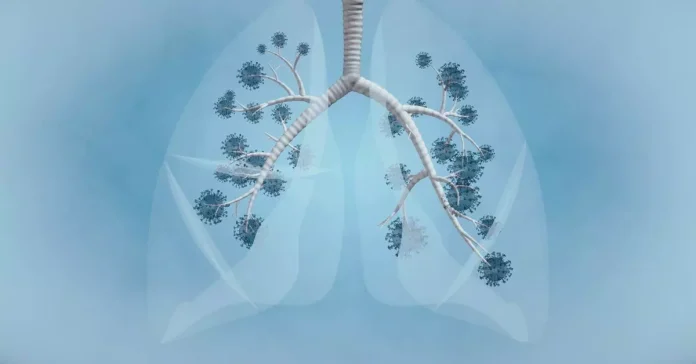Pneumonia is a consequential lung infection that deserves attention because it can be severe. Understanding the signs and effective prevention strategies are crucial for protecting respiratory health. This article will explore the eight main signs of pneumonia and provide practical strategies to combat and prevent this common ailment.
Here are the 8 Signs and Strategies Against Pneumonia
Persistent Cough
If you have a persistent cough with mucus, it might indicate the early stages of pneumonia. The infection causes inflammation and fluid buildup in the lungs, leading to respiratory symptoms. If you’re experiencing these signs, seeking medical attention promptly for an accurate diagnosis and timely treatment is essential.Shortness of Breath
If you’re having difficulty breathing or experiencing shortness of breath, it could be a sign of compromised lung function, potentially indicating pneumonia. It’s crucial to seek urgent medical attention to assess your respiratory health, enable early diagnosis, and start timely interventions for optimal recovery.Chest Pain
Chest pain may manifest as a symptom of pneumonia, underscoring the importance of distinguishing it from other causes. Proper evaluation by healthcare professionals is crucial to accurately identify pneumonia-related chest pain and ensure appropriate treatment, addressing the infection and any underlying concerns.Fever and Chills
Fever and chills are common indicators of pneumonia, signaling the body’s immune response to the infection. Recognizing these symptoms is vital for seeking timely medical attention, as they often accompany the body’s efforts to combat the respiratory infection effectively.Fatigue
Persistent fatigue, lasting beyond usual tiredness, may indicate a potential sign of pneumonia, revealing the body’s fight against the infection. Recognizing this prolonged fatigue is crucial, as it can affect overall energy levels, requiring prompt medical attention for a comprehensive evaluation and appropriate management of pneumonia.Confusion
In older adults, pneumonia may present with potential cognitive symptoms, underscoring this demographic’s need for heightened awareness. Recognizing subtle changes in cognitive function is essential, as it can aid in early diagnosis and timely intervention to ensure optimal care for older individuals impacted by pneumonia.Lowered Appetite
A sudden loss of appetite can accompany pneumonia, contributing to overall weakness. This symptom underscores the impact of the infection on the body’s energy levels and nutritional intake. Addressing the loss of appetite is crucial in managing pneumonia effectively and supporting the body’s recovery.Blue Lips or Nails
Cyanosis, showing a bluish tint in the lips or nails, is a severe sign linked to low oxygen levels. If someone with pneumonia has this symptom, getting medical help is crucial. Recognizing cyanosis is essential because it signals a significant problem with breathing, and quick action is needed to address the breathing difficulties and ensure enough oxygen in the body.
Strategies Against Pneumonia
Vaccination
Highlighting the significance of vaccinations, especially the pneumonia vaccine, is crucial in preventing specific types of pneumonia. Vaccination is a proactive measure to bolster the body’s immunity and protect against infections, underscoring the importance of routine immunizations in maintaining respiratory health and reducing the risk of pneumonia.Hand Hygiene
Proper hand hygiene is pivotal in lowering the risk of respiratory infections, including pneumonia. Regular and thorough handwashing with soap and water helps eliminate germs that can lead to respiratory illnesses. This simple, yet effective measure is crucial in preventing the spread of infections, emphasizing the importance of incorporating good hand hygiene practices as a fundamental strategy for respiratory health and infection prevention.Respiratory Hygiene
Practicing good respiratory hygiene, like covering the mouth and nose when coughing or sneezing, is significant in preventing the spread of respiratory infections, including pneumonia. This simple act helps contain respiratory droplets that may contain infectious agents, reducing the risk of transmitting the illness to others. Emphasizing and adopting such hygiene practices are vital in promoting community health and minimizing the transmission of respiratory infections.Maintaining a Healthy Lifestyle
Encouraging a healthy lifestyle, which includes maintaining a balanced diet, regular exercise, and ensuring adequate sleep, is essential for supporting overall immune function. These lifestyle factors contribute to a robust immune system, enhancing the body’s ability to defend against infections like pneumonia. Promoting and adopting these habits is vital to fortifying overall health and resilience against respiratory illnesses.Avoiding Smoking and Secondhand Smoke
Emphasizing the harmful effects of smoking and exposure to secondhand smoke is crucial for understanding their detrimental impact on respiratory health, significantly increasing vulnerability to pneumonia. Smoking harms the lungs and weakens the immune system, making people more prone to respiratory infections. Recognizing and addressing the risks associated with tobacco smoke is paramount in safeguarding respiratory well-being and reducing the likelihood of pneumonia.Avoiding Excessive Alcohol Intake
Excessive alcohol consumption increases the risk of respiratory infections, including pneumonia. Drinking alcohol can weaken the immune system, making the body more vulnerable to infections. Understanding this link highlights the importance of moderation in alcohol intake to maintain a robust immune response and reduce the risk of respiratory illnesses, reinforcing the connection between lifestyle choices and overall respiratory health.Prompt Treatment of Respiratory Infections
Underlining the importance of seeking prompt medical attention for respiratory infections is crucial to prevent complications, such as pneumonia. Early diagnosis and treatment significantly reduce the risk of infections progressing to more severe conditions. Emphasizing the need for timely medical intervention is a proactive approach to safeguarding respiratory health and mitigating potential complications.Environmental Consideration
Highlighting the significance of maintaining a clean and well-ventilated living environment is crucial in minimizing exposure to respiratory pathogens. Good hygiene practices, regular cleaning, and proper ventilation help reduce the presence of infectious agents in the air, lowering the risk of respiratory infections, including pneumonia. Prioritizing a healthy living space is integral to overall respiratory wellness and contributes to a proactive defense against respiratory pathogens.
Conclusion
Understanding these eight signs and strategies allows people to take proactive steps to protect against pneumonia. Recognizing symptoms early and adopting preventive measures are crucial for maintaining excellent respiratory health. Staying informed and actively implementing these strategies enables us to combat pneumonia and build a healthier future collaboratively.
Frequently Asked Questions (FAQs) About Pneumonia
What is pneumonia, and how does it impact the lungs?
Pneumonia is a lung infection that causes inflammation, impacting the air sacs in the lungs and leading to symptoms like cough, fever, and difficulty breathing.
What are the early signs of pneumonia?
Early signs include persistent cough with mucus, difficulty breathing, chest pain, fatigue, unexplained weight loss, fever, night sweats, and potential cognitive symptoms in older adults.
How can I differentiate between regular and pneumonia-related coughs?
A persistent cough lasting three weeks or more, especially with mucus, may indicate pneumonia. If in doubt, consult a healthcare professional for proper diagnosis.
Can pneumonia be prevented through vaccinations?
Yes, certain vaccines, like the pneumonia vaccine, can prevent specific types of pneumonia.
Is pneumonia only a concern in older adults?
Though older adults are more at risk, pneumonia can affect people of any age. Certain factors, like a weakened immune system, can increase the risk.
How can a healthy lifestyle contribute to preventing pneumonia?
Maintaining a balanced diet, regular exercise, adequate sleep, and avoiding excessive alcohol and smoking can support overall immune function, reducing the risk of respiratory infections.
Can pneumonia be transmitted through casual contact?
Respiratory droplets typically transmit pneumonia. While casual contact is less likely to transmit the infection, prolonged exposure in confined spaces may pose a risk.
What should I do if I suspect I have pneumonia?
Seek prompt medical attention if you experience persistent symptoms like cough, difficulty breathing, or chest pain. Getting diagnosed and treated early is crucial for a better chance of recovery.










